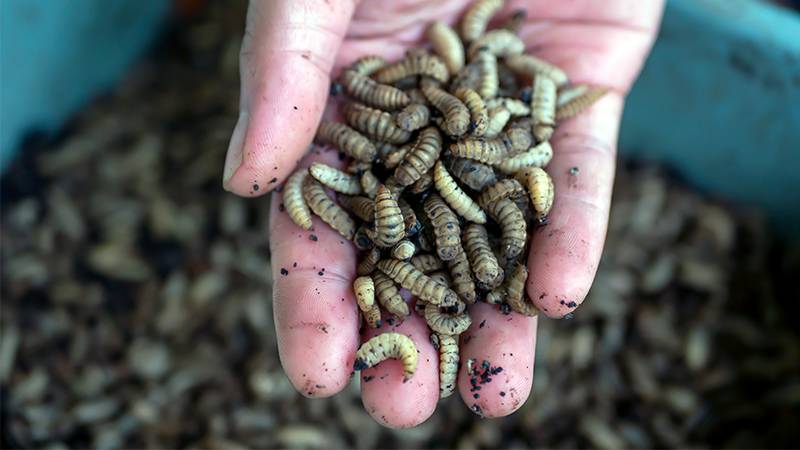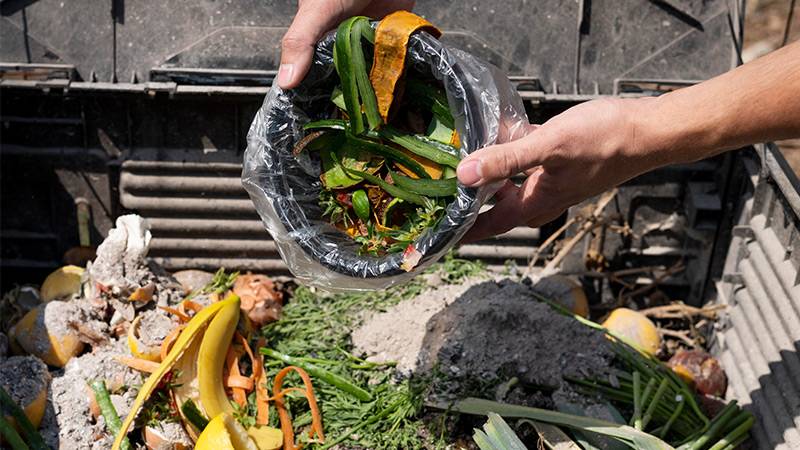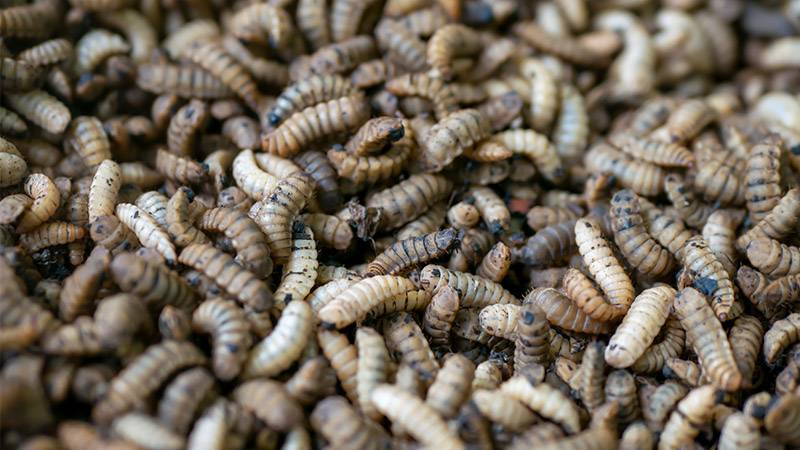If you’ve ever uncovered your compost heap to find it writhing with maggots, you know it can be quite an unsettling sight. Inevitably, the question arises — are these tiny, squirming creatures a sign of a healthy composting process, or do they spell trouble for your carefully collected pile of kitchen scraps and garden waste?
In this comprehensive guide, we’ll explore everything you need to know about maggots in compost. From their pros and cons, types, causes, prevention methods, to proven solutions for dealing with an infestation, our aim is to demystify these compost dwellers and help you master the art of composting.
Are Maggots in Compost Good or Bad?
The Good: The Benefits of Maggots in Compost
For starters, let’s set the record straight — maggots in compost are not harmful to you or the environment.
They can, in fact, play a significant role in organic matter decomposition, thereby supporting the composting process.
These wriggly larvae are voracious eaters and can consume large amounts of organic waste, from kitchen leftovers to garden clippings. As they feast on your rotting fruits and vegetables, maggots help to accelerate the breakdown of this waste material, effectively turning your compost bin into a hotbed of nutrient-rich compost.
Whether they’re found in an outdoor compost pile or an indoor compost bin, these tiny creatures can be beneficial. Some gardeners even welcome them as they can expedite the transformation of your food scraps into compost, which ultimately serves your garden better.
The Bad: Potential Drawbacks of Maggots in Compost
But it’s not all roses when it comes to maggots in compost. A major concern is that they can lead to an increase in adult flies, a nuisance that most people understandably want to avoid. In an indoor compost bin, this can be especially unpleasant.
While maggots do contribute to the decomposition process and the creation of nutrient-rich compost, there is such a thing as too much of a good thing.
An excess of maggots can eat too many of the nutrients, leaving you with compost sludge that offers little in terms of nutrition for your garden. This is where finding a nutrient balance in compost becomes crucial.
Additionally, their presence in large numbers can be quite unsettling and gross, even for the most seasoned composters. While preventing maggots in compost might not be a concern for everyone, for some, it becomes a necessity for an overall pleasant composting experience.
In the following sections, we’ll delve into how to achieve that balance and control maggot infestations effectively. But first, let’s talk about the types of maggots that can be found in compost.
Types of Maggots in Compost
Identifying Different Types of Maggots
A compost pile can host a diverse group of maggots or larvae, which come from different species of flies. Here are two common types:
Black Soldier Fly Larvae (Hermetia illucens)
Perhaps the most frequent visitors to your compost bin, these maggots are the larval life stage of compost-dwelling soldier flies.
Young soldier fly larvae are gray-white, about 1 inch in length, and very active. As they mature, the larvae turn a dark brown color, are torpedo-shaped, and flattened, with tough-looking skin. They are easily distinguishable as they lack legs and feature only hairs and spines.
Adult soldier flies, on the other hand, are black and about 5/8-inch long, with smoky black wings.
These adults can lay up to 500-900 eggs, which typically hatch within four days.

Housefly Larvae (Musca domestica)
Another common type of maggots found in compost, housefly larvae are smaller than black soldier fly larvae, measuring just half an inch at their most mature stage.
They are pale white and taper towards the head.
A single housefly can lay up to 150 eggs at a time, which can hatch in as little as 24 hours.

Read More:
What Each Type Means for Your Compost
The types of maggots in your compost can signal different things about its health and condition.
Black Soldier Fly Larvae
These larvae are voracious consumers of high-nitrogen materials, such as kitchen food scraps and manure, which they turn into nutrient-rich compost.
Additionally, when the larvae pupate or die, they contribute nitrogen and glucose to the compost, benefiting decomposer bacteria. They also introduce beneficial decomposer bacteria and fungi from other sources into your compost pile.
If you see these guys in your apartment’s compost bin, it’s generally a good sign, indicating that your compost is a suitable, nutrient-rich environment.
Housefly Larvae
While these maggots also contribute to organic matter decomposition, their presence can indicate over-moist conditions or the presence of meat or dairy products, which are generally not recommended for home compost piles.
Large numbers of housefly maggots might also lead to an increase in the adult fly population, which can be a nuisance and potentially carry diseases.
Recognizing the types of maggots in compost and understanding their role can help you optimize your composting process and maintain the health of your compost bin.
Causes of Maggots in Compost
Environmental Factors Attracting Maggots
Several environmental factors in your compost bin can attract maggots, especially black soldier flies. Understanding these factors is the first step to preventing an infestation.
Here’s what you need to know:
Compost Moisture Level
A compost pile that is too wet offers an inviting environment for maggots. The high humidity from moist food waste, such as fruits and vegetables, is particularly attractive to them.
Temperature
Warm temperatures speed up the decomposition process, attracting flies looking for a place to lay their eggs. Maggots are more likely to be found in compost bins sitting out in the sun.
Presence of Certain Types of Waste
Black soldier flies are attracted to a free source of food in your compost. This could include everything from animal manure to kitchen waste.
Common Composting Mistakes Leading to Maggots
Even the most seasoned composters can make mistakes that inadvertently invite maggots into their compost pile. Here are a few of the most common missteps:
Compost Imbalance
An imbalance between “greens” (wet, nitrogen-rich material like vegetable scraps) and “browns” (dry, carbon-rich material like leaves or hay) can cause your compost pile to become too moist. This invites flies to congregate and lay their eggs.
Food Waste in Compost
Adding too much food waste to your compost can make it especially attractive to flies. Excess food waste and manure might cause such an imbalance that it becomes a breeding ground for maggots.

Compost Oversaturation
Not turning your compost pile regularly or allowing it to get too moist can lead to oversaturation. This excessive moisture creates wet spots, ideal for black soldier flies to lay their eggs.
Unnoticed Flies
Often, flies can go unnoticed in and around compost bins. Tiny fruit and house flies can get into small cracks and lay eggs that are almost invisible to the naked eye, leading to a surprising maggot infestation.

Read More:
Preventing Maggots in Your Compost
Composting Practices to Keep Maggots Away
Maintain a Balanced Pile
The key to a healthy compost pile is balance. A good mix of green (nitrogen-rich ingredients) and brown materials (for a 2:1 ratio) will prevent a host of compost pests, including maggots.
Brown materials include items like dry grass, leaves, and shredded paper. Ensure to cover nitrogen sources by at least two inches.
Limit Grass Clippings
While grass clippings can contribute to your compost pile, it’s best not to add huge amounts at once.
Thick layers of fresh-cut grass may attract flies, leading to a maggot infestation. It’s better to spread out the clippings and let them dry before adding them to the compost pile.
Turn the Pile Regularly
Regular turning of your compost pile will discourage flies from laying their eggs and will prevent buildup of excess heat and moisture. Both of these factors can lead to an increase in maggots.
Exclude Certain Food Waste
While composting is an excellent way to dispose of food waste, it’s important to avoid composting certain items that can attract flies. This includes meat, dairy products, and fats. While these items do break down eventually, they do so slowly, providing a food source for flies in the meantime.
Selecting the Right Compost Bin for Maggot Prevention
Open Compost Bin
While an open compost bin has its benefits such as natural aeration and moisture from the environment, it can be a haven for flies and maggots if not properly managed.
Sealed Compost Bin
A sealed compost bin can be a good option if you’re dealing with a persistent maggot issue. These bins will generally keep pests out, but remember to turn the pile often to prevent excess heat and moisture build-up, which can also lead to maggot infestations.
Tumbler Composter
A tumbler composter or enclosed compost system can help to keep flies at bay. Covering holes with a window screen can prevent flies from entering and laying eggs while still providing ventilation.
Getting Rid of Maggots in Your Compost
Natural Methods to Control Maggots
Maggots, especially black soldier fly larvae (BSFL), can sometimes be beneficial in the composting process, but too many can cause imbalances. Here are a few natural methods to control these uninvited guests:
Alter the Composition
One of the most straightforward methods is to adjust the “greens” and “browns” ratio.
Greens refer to nitrogen-rich materials like food scraps, while browns refer to carbon-rich materials such as dried leaves or shredded newspaper. Increasing the amount of browns can make the compost environment less appealing for maggots, as it dries out the compost.
Add Lime
Lime can be used to elevate the compost’s pH, creating an unfavorable environment for maggots. However, caution is necessary when using lime as it can render the compost too alkaline, impacting its overall health and future usefulness in the garden.
Use Vinegar
Similarly, adding vinegar to your compost increases its acidity, making it less attractive to flies and their larvae. A tablespoon for every 20 pounds of compost is typically sufficient.

Let Nature Do the Work
If you’re not too squeamish, leave the maggots where they are. They’re not harmful and can help break down waste more quickly.
Alternatively, if you have chickens or other wild birds nearby, let them feast on the larvae. It’s a great way to control the maggot population while providing a nutritious treat for the birds.
Composting Tools and Products That Can Help
Sometimes, natural methods might not be enough, and some additional tools or products can help:
Use an Enclosed Composter with Screens
If you’re starting anew, consider getting an enclosed composter. Many models come with built-in screens that allow for airflow while preventing BSF from getting inside to lay eggs.
Mesh Wrap for Open Air Bins
For existing open-air bins, wrapping them with mesh screens can deter flies from laying eggs. Though this method might not be entirely foolproof, it significantly reduces the likelihood of a maggot infestation.
Fly Traps
Hanging fly traps near your compost can be helpful in controlling the fly population, hence reducing the number of maggots in your compost. These traps lure in flies, trap them, and prevent them from laying eggs.
Remember, successful composting often involves a delicate balance. While these tips and tools can help manage maggot populations, they may not eliminate the issue entirely. Continual observation and adjustments to your composting process can ensure a healthier compost pile.
Frequently Asked Questions (FAQ)
Yes, it’s generally okay to have maggots in compost. They contribute to breaking down organic material and transforming it into nutrient-rich compost. However, a large infestation can indicate an imbalance in the compost pile, such as too much green (nitrogen-rich) material, and might necessitate intervention.
If maggots appear in your compost, balance it by adding carbon-rich materials like dried leaves or wood chips. Regularly turn the compost to discourage excess moisture. Lime, vinegar, or fly traps can also help. Ensure any method chosen doesn’t harm beneficial composting organisms.
Maggots typically appear in compost bins due to an excess of green materials (nitrogen-rich food waste), inadequate turning leading to oversaturated areas, or the presence of enticing food sources for flies. Improperly sealed bins also invite flies to lay eggs, which hatch into maggots.
To keep compost maggot-free, balance green and brown materials, turn the compost regularly, avoid composting meat, dairy, or fats, and maintain a dry top layer. Using sealed or tumbler compost bins with proper aeration can also help. Additionally, lime or vinegar can be added to create an unfavorable environment for maggots.
Conclusion
While alarming, maggots in compost are manageable and can even aid decomposition. Prevention is key—balance compost materials, regularly turn the pile, and pick the right bin.
If infestations persist, natural control methods and composting tools can be useful.
Remember, composting is an adaptive learning process. Despite challenges, don’t let the sight of maggots deter you from this rewarding, environmentally-friendly practice. Keep composting!


